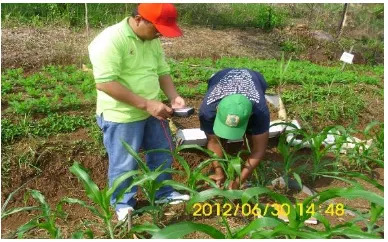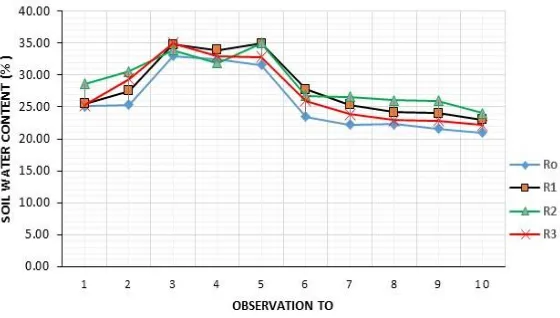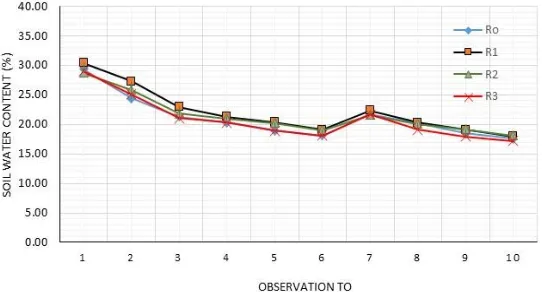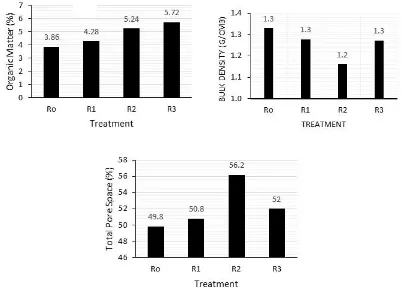Volume 9, Issue 4, April 2018, pp. 181–188, Article ID: IJCIET_09_04_020
Available online at http://www.iaeme.com/ijciet/issues.asp?JType=IJCIET&VType=9&IType=4 ISSN Print: 0976-6308 and ISSN Online: 0976-6316
© IAEME Publication Scopus Indexed
THE EFFECT OF RECLAMATION TO SOIL
MOISTURE CONTENT IN THE ROOTING ZONE
ON DRY LAND
Aprisal
Soil Conservation Laboratory of Agriculture Faculty, University of Andalas, Padang, Indonesia
Bujang Rusman
Soil Physics of laboratory of Agriculture Faculty, University of Andalas, Padang Indonesia
Yulnafatmawita
Soil Physics of Agriculture Faculty, University of Andalas, Padang Indonesia
ABSTRACT
The critical land reclamation through the conservation farming system could improve the properties of soil such as pore of water available. Thus the land was able to increase the availability of soil water in the zone of rooting annuals. The purpose of the research was to analyze the effect of Reclamation land with conservation farming system to the fluctuation of groundwater in zones rooting annuals. The research method used was an experiment in the field by using the block design in the form of split plot. As the main plot was a conservation tillage system (not reclaimed Ro, reclaimed using mulch R1, reclaiming compost and manure use R2 and reclamation with round up weed R3) and sub plots were the three types of annuals (corn T1 T2 T3, peanuts, and watermelon). Groundwater data monitored using gypsum blocks put in rooting zone about 30 cm in the soil. The soil moisture was measured with ohm meter every day at noon (12.00-13.00). The measured data are calibrated with graphs of soil moisture which has been standard. Then the results are presented in the form of trend graphs of each treatment of the reclaimed land. The research results showed that the fluctuations of the water in the rooting zone higher on land that was not reclaimed (To) than on land reclaimed. Land reclaimed by using compost, manure (T2) tend to be more stable and increases the moisture content of the soil
Keywords: Moisture, reclamation, rooting zone, soil water.
Cite this Article: Aprisal, Bujang Rusman Yulnafatmawita, The Effect of Reclamation to Soil Moisture Content in the Rooting Zone on Dry Land, International Journal of Civil Engineering and Technology, 9(4), 2018, pp. 181–188.
1. INTRODUCTION
The Dry land is land which is in cultivated for agriculture rely on water from rainfall. Farmers depend on rainfall once in the cultivated the dry land. Many drylands that abandoned because of less water caused by low rainfall, while the evapotranspiration water deficit so high. Around the Catchment (DTA) Singkarak many drylands covered by reeds because not processed by farmers, so that its territory was impressed and critical neglect. Furthermore [1] also reported that conventional farming systems that burn organic materials and dispose of the rest of the harvest have been accelerating the onset of degradation of farmland in America. [2] [3] also state that the rest of the harvest or burning the grass has caused declining soil organic matter content. Means of disposal-and combustion of organic materials and the rest of the harvest on the land of agriculture will accelerate the occurrence of critical land.
In Nagari Aripan in DTA Singkarak enough land area reeds like this critical land. The critical land is land that has already lost its function as the medium grows as accommodating, save water and provides water in the rooting zone for plant growth. According to Have [4], a critical land overgrown with reeds in Kanagarian Solok Regency Aripan its spread is quite extensive, where about 35% of the total area of 4,460 ha in area. Kanagarian Aripan lies in the rain shadow, with rainfall that is not predictable. The research of [5] reported that the DTA Singkarak including the shadow rain because rain from Western area bordering the Bukit Barisan orografis has rained in this area so that in the DTA only rain shadow. Land dominant in Aripan this is an Ultisol Nagari. The problem in addition to the availability of water in this area is a poor physical property. Ultisol characterized by horizon identifier, i.e., horizon argilik; namely, the accumulation of clay on the horizon beneath the surface thus reducing water pervasive [6].
This land management to farming can be done by processing the land conservation; i.e., tillage followed by addition of organic material each growing season or giving of minimum tillage and mulch. The purpose of this research was to look at the fluctuation of soil moisture in the rooting zone of annuals in the dry season.
2. MATERIAL AND METHODOLOGY
2.1. Experimental DesignThe study was designed with the design of split plot (RPT), as the main plot is tillage (R) as the main plot and annuals (Ts) as the son of the swath. We would like to see the influence of tillage and crop treatment against water content of the soil in the zone rooting annuals. Soil moisture levels are measured every day by the blocks of gypsum sensors and a Multitester. Data obtained in averaged and serve with the graph. The data presented in this paper is the moisture content of dry season whether or not raining the past few days, with water content fluctuation to see the soil in the zone where the treatment of root, which has a higher water content when the weather is the dry season. On climate as this happens water deficit because evaporation is greater. [7] researches a variety of soil moisture content of soil layers at the time of the summer climate fluctuations, which in the event of a water deficit due to greater evaporation than precipitation.
The main plot (R) used is a 4-way tillage conservation tillage such as below:
R0: reeds burned and processed in conservation land (land of the hoe and chopped one time, commonly done by farmers).
R2: Reed Rhizome and leaves then cut down reeds chopped then to be composted. Soil processed in accounting for its limestone CaCO3 + 1 ton. ha-1 + 10 tons of manure. ha-1 and compost reeds 7 ton. ha-1.
R3: Grass spray in reeds with Roun Up soil at a minimum though.
Sub Plots (Ts) is three types of annuals, which are:
Ts1: Corn Plants
Ts2: Soybean Plants
Ts3: Plant Peanuts
Table 1 Combination treatment ways of processing of soil moreover, vegetation in the DTA-Singkarak.
Main plot Annual crops
Conservation tillage
(PTK) corn (Ts1) Soybeans (Ts2) Peanuts (Ts3)
R0 R0Ts1 R0Ts2 R0Ts3
R1 R1Ts1 R1Ts2 R1Ts3
R2 R2Ts1 R2Ts2 R2Ts3
R3 R3Ts1 R3Ts2 R3Ts3
Table 1 above explained that 12 treatment combinations are performed in the field. Each treatment combination is repeated three times, so the total number of units of the experiment is a 4 x 3 x 3 = 36 unit the experiment. For more details, the floor plan of the unit placement experiments in the field.
2.2. The Implementation
Land preparation and manufacture of Experimental Plots Land Reed selected restricted (plotted) with plastic straps according to the size and the number of experimental plots. Map any way tillage (R) is done randomly. After the land was opened then plotted following the treatment cultivated soil (R) are already defined and made as the main plot (where the size of each of the main plot is 2.5 m x 18 m) distance between the main plot is 0.5 m. After the opening of the land done, done following planting species of plants (T) which has been designed and made as a sub plotted-size swath of 2.5 m x 6 m, the distance between each sub plotted 0,5 m. Laying of sub plott each swath of the main plot is done randomly.
Installation Tool Gypsum Block on Experimental Plots Sensors gypsum blocks mounted on each experiment plots. Gypsum on planting in the soil in the area of plant rooting zone at a depth of 20 cm. The soil made the hole with a drill belgei, then gypsum entered and deposited with the land back.
2.3. Measurement of Soil Water Content
The Soil water content was measured by using the ohm meter. The measurement is done at the Block Gypsum by measuring electric prisoner between electrodes in the block. Block gypsum is conductivity quickly and easily be balanced by water absorbed by the soil. When the ground gets wet, the pores in the water and dissolve gypsum, enough to make a saturated solution of calcium sulfate as an electrolyte resulting in an electric current [8] . Measurement of the moisture content of the soil is done every day at around 12.00-13.00. Soil moisture content is measured only the time the dry season, to be able to see fluctuations in soil water content due to evaporation and soil water holding capacity.
2.4. The Taking of Soil Samples
Preliminary soil samples were taken from the treated soil, and after three months the treated soil for soil samples. Soil samples were taken from each experimental plots for the analysis of physical properties of soils (texture, Volume Weight, Total Pore Space and C-Organic soil). Each soil sample was taken at a depth of 0-20 cm. Soil samples were analyzed in the laboratory to find out the physical properties of the soil affects the moisture content of the soil.
3. RESULTS AND DISCUSSION
3.1. The characteristics of the soil on site Research
Before the initial soil, analyses researched to find out the nature of the ground before it is treated. The initial soil analysis results as in table 1. Based on the comparison nature of the land of the land areas of research have the texture class clay with clay is 52.92 %. While the bulk density (BV) belongs to the high-value assignment 1.26 g/cm3. A total of 49% pore spaces including low and organic materials low, i.e. also of 2.65 %.
Table 2 Characteristics of land located at Nagari Aripan research on DTA Singkarak The initial soil properties value Criteria
clay properties, soil characteristics, then like the TRP and organic matter, the soil is low. This can be caused by a high bulk density, and consequently, the soil becomes solid.
3.2. Rainfall
3.3. Water Content of Soil
Based on the results of the measurement of moisture content in the zone rooting annuals as measured in July 2012 look at Pictures 1 and 2. In the first-month chart fluctuation in soil moisture content during the dry season rooting zone is seen to have the trend is down for all the treatments.
The real decline is visible on the sixth observation (Figure 1) until the 10th day of observation. Even if the trend rate of the same content but among the treatment seen processed in soil conservation (R1, R2, and R3) have a higher moisture content than conventional processed soil treatment (Ro). While the observations today to 10 months to two, kadanungan ground water on the first day had started rooting zone down in Figure 2. The pattern of decline in soil moisture content is the same, and the relative levels of
Figure 1 Rainfall graphs provide research in Nagari Aripan Singkarak from June until August 2012 (Rainfall station Balitbu Aripan).
Figure 3 Graph of water content in soil to two weeks to two on a 10-day Observation in August 2012
Land also is no different. This is due in the first month of this research the influence of treatment has not been visible due to annuals also has yet to develop. Research results [7] describes the lower soil moisture also strongly affected by the cycle of the rainy season and the dry season and soil factors. According to [10] stated that the moisture content of the soil was strongly influenced by the condition of the soil properties (physical, chemical, and biological soil). The high content of soil organic matter can increase water retention in the soil matrix. [11] also describes the relationship of soil water and evaporation, the soil water content is the amount of water held in the soil after excess water flowed if the soil has a high water content, so excess ground water is reduced through evaporation, transpiration, and underground transporter. To know the levels of soil moisture can be used many kinds of techniques, such as the following can be done directly through the measurement of the difference in the weight of the land (called the gravimetric method) and indirectly through the measurement of other properties that are closely related to soil water. The measured soil water content is the manifestation of wet and dry periods of climatic conditions.
Soil organic matter, Bulk Density, and Total pore space The content of soil organic matter is seen in Figure 4a, indicating conservation tillage treatment (R1, R2, and R3) is higher than conventionally prepared soil (Ro). Organic materials including moderate to high criteria in soil that is processed in conservation. The high content of organic matter on this conservation tillage treatment is due to the addition of organic matter in the form of mulch, compost, and manure. The granting of these organic substances that cause an increase in soil organic matter. According to [12] organic materials were given to the land also need time to decay. Report of the research of [13] on Ultisol Peranap Riau for increasing Organic C from 1.73% 1.59% to stable which will take approximately eight months.
space fig. 4 c. The highest total pore space found in the tillage treatment given the compostand manure (R2). The pore spaces in the soil are very important for the storage of water and air in the soil. The ability of water and air for rooting plants depends on the soil pores that are useful in the soil. According to [15]
Figure 4 The effect of reclamation to; soil organic matter (a), bulk density (b), and total soil pore space (c).
Shows that moisture of land planted with corn on the ground 0-30 cm has a higher moisture content compared to the deeper layers of soil. This is because of the layer though it had deposits of organic material is higher, i.e., 1.41% compared to a deeper layer, i.e., 0.61%. Although the land was 44 % and lower than the lower soil layers, i.e., 48 %. However, it will be because the role of organic material can increase the water retention of the soil.
4. CONCLUSIONS
By the deliberations of the research results, it can be taken a few conclusions:
1. conservation tillage given organic manure and compost can improve the physical properties of soil organic matter, such as weights, and the total volume of pore spaces in the soil.
2. The content of ground water in the dry season have fluctuated declining for ten days of observation in July and August. Treatment of organic materials and granting the compost tended to have higher soil water content.
ACKNOWLEDGMENT
REFERENCES
[1] Barrow. C. J. 1991. Land degradation. Departement and breakdown of terrestrial environments. Cambridge University Press. Cambridge.
[2] Bissett, J. and D. Parkinson. 1980. Long-term effects of fire on the composition and activity of the soil microflora of subalpine, coniferous forest. Canadian Jurnal of Botany 58:1704-1721.
[3] Dumontet, S., H. Daniel, A. Scopa, A. Mazzara, and A. Saracino. 1996. Post-fire soil microbial biomass and nutrient content of a pine forest soil from a dunal. Mediterranean environment. Soil Biology and Biochemistry 28:1467-1475.
[4] The Guardian Exposed Nagari Aripan Sub X Koto Singkarak. (2009). In the framework of the assessment of Solok Regency level achievers Nagari on 13 Mai 2009.
[5] Aprisal, Rusman, b. d., Indra, Refdinal, Erlina, r., Fajriwandi. 2016. Rusman, the dynamics of some physical properties of soils under conservation farming system on the critical land Aripan in the data Singkarak. National Land Conference papers Sub Optimal FOB Palembang 20-21 October 2016.
[6] Adiningsih, j. s. and Mulyadi. 1992. The rehabilitation techniques and Alternative land use reeds. In PPT (ed). Land use reeds to sustainable farming. Pros. Seminar land reeds. Bogor, 1 December 1992
[7] Longobardi, A. 2008. Observing soil moisture temporal variability under fluctuating climatic conditions. Paper for the journal Hydrology and Earth System Sciences. Department of Civil Engineering, University of Salerno, Via Ponte Don Melillo. 84084 Fisciano (SA), Italy
[8] Candra. A. 2012. Moisture Content Distribution On Plant Root Zone (Unsaturated Zone) of Bandung Tea Plantation, South Bandung. J. Dinamika Rekayasa Vol. 8 No. 1 2012 (13-17)
[9] Oldeman. L. R. Irsal Las and S. N. Darwis. 1979. An Agroclimatic map of Sumatera Contribution. Central Research Institute for Agriculture No. 52 Bogor. Indonesia. 120 page
[10] Hillel.D. 1980. Fundamentals of soil physics. Department of plant and soil science. University of Massachusetts. Academic Press. Sydney
[11] Gardner, W. R.: 1983. Soil properties and efficient water use: An overview, in Limitations to efficient water use in crop production, edited by Taylor, H. M., Jordan, W. R., and Sinclair, T. S., ASA-CSSA-SSSA, Madison, USA, 45–64,. Garrigues, E., Doussan, C., and Pierret, A.: Water Uptake by Plant
[12] Anderson, J.M, and J.S.Ingram. 1993. Tropical soil biology and fertility. A. Handbook of methods. CAB International, Wallingford.
[13] Aprisal. 2000. A review of land reclamation of marginal reeds and integrated farming system model to build sustainable agriculture in areas of Resettlement Pandan Wangi Peranap Riau. Graduate School Of Bogor Agricultural University. Bogor, West Java [14] Revees.D.W. 1997. The Role of soil organic matter in maintaining in soil quality in
continuous cropping system. J. Soil and Tillage Research 43.1997 (131-167)



